Results show that fish species dominated the bycatch, followed by tunicates and other crustaceans
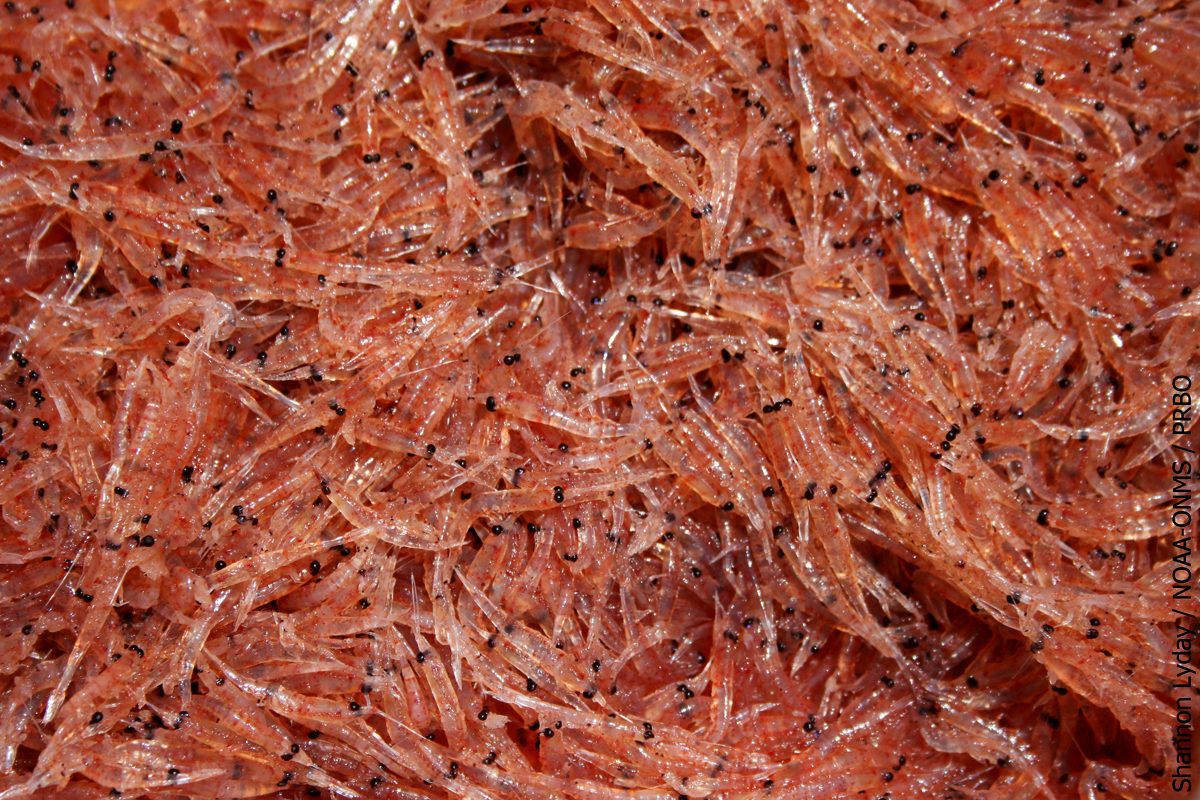
The Antarctic krill (Euphausia superba) is an important fishery resource in the Southern Ocean, and its commercial exploitation is expected to increase as a source of protein for human and animal consumption. The fishery is managed under the Convention for the Conservation of Antarctic Marine Living Resources (CCAMLR), which applies a precautionary approach with a set annual catch limit for the southwest Atlantic sector of 620,000 tons.
This management approach was used to safeguard against potential detrimental effects on other ecosystem components, including the Antarctic krill population itself, from effects of localized overexploitation with insufficient knowledge. The total annual catch of Antarctic krill from this region ranged from 160,000–450,000 tons during 2010–2020.
The definition of bycatch used by CCAMLR includes “the incidental catch of all living and non-living material (excluding target species).” Antarctic krill are utilized by humans primarily in two ways, firstly in an indirect fashion as fish meal for aquaculture and secondly, the oil is directly consumed by humans in health food products such as Omega-3 oils. Given the size of the fishery, the importance of its products to human populations, the exploitation rate relative to estimated global stock size and consequently the desire to expand the fishery, understanding the degree and significance of bycatch and its impact on Southern Ocean ecosystem processes is becoming increasingly important.
This article – summarized from the original publication (Krafft, B.A. et al. 2022. Bycatch in the Antarctic krill (Euphausia superba) trawl fishery. Fisheries Management and Ecology Volume 30, Issue 2, April 2023, pages 154-160) – reports on a study to characterize the degree, significance and functional diversity of bycaught taxa within the trawl fishery for Antarctic krill.
Study setup
The fishery for Antarctic krill has a year-round season, starting on Dec. 1 and ending on Nov. 30 of the following year. Herein, each CCAMLR fishing season was designated as the year in which the fishing season began. SISO observers used two different sampling strategies during the study period. From 2010 to 2018, observers collected 25 kg sampled randomly from the trawled catch, from which taxa were sorted.
After all bycatches had been sorted from 25-kg samples, observers re-examined a 10-kg subsample and two 1-kg sub-samples of each 25-kg sample. Beginning in 2018, the procedure was changed to only examine the 25-kg sample, because 98 percent of species present were identified from the 25-kg sub-sample.
As the fishery has both a spatial and seasonal pattern of operation, we further decomposed this bycatch into its spatiotemporal distribution with the goal of providing more management-relevant information. Specifically, understanding spatiotemporal patterning of bycatch throughout the current distribution of the fishery may provide insight into potential bycatch issues should the fishery either expand into previously unfished areas or re-enter historical fishing grounds for which no information exists. To achieve this, we analyzed data from the Observer Bycatch (krill) dataset of the CCAMLR C1 fisheries database for the period over which CM51-07 has been in effect (2010–2020), including registrations from the entire fishing fleet targeting Antarctic krill. For detailed information on the data and analyses, refer to the original publication.
Will krill fulfill its promise as an aquaculture feed ingredient?
Results and discussion
Sporadic reports representing parts of data associated with bycatch in the Antarctic krill fishery exist, but our study is the first time these data have been reviewed in the context of characterizing their ability to describe bycatch rates and composition in different fishing areas and throughout the season.
During the 2010–2020 fishing seasons in the southwest Atlantic sector of the Southern Ocean and across the Scotia Sea fishing only occurred in Subareas 48.1, 48.2 and 48.3 (Fig. 1). Total annual fishing effort averaged 4591 hauls (SD = 734 hauls) and observer coverage averaged 20 percent. Fish dominated in the bycatch in all three areas, followed by tunicates in the 48.1 and 48.2 areas, and other crustaceans and tunicates in Subarea 48.3.
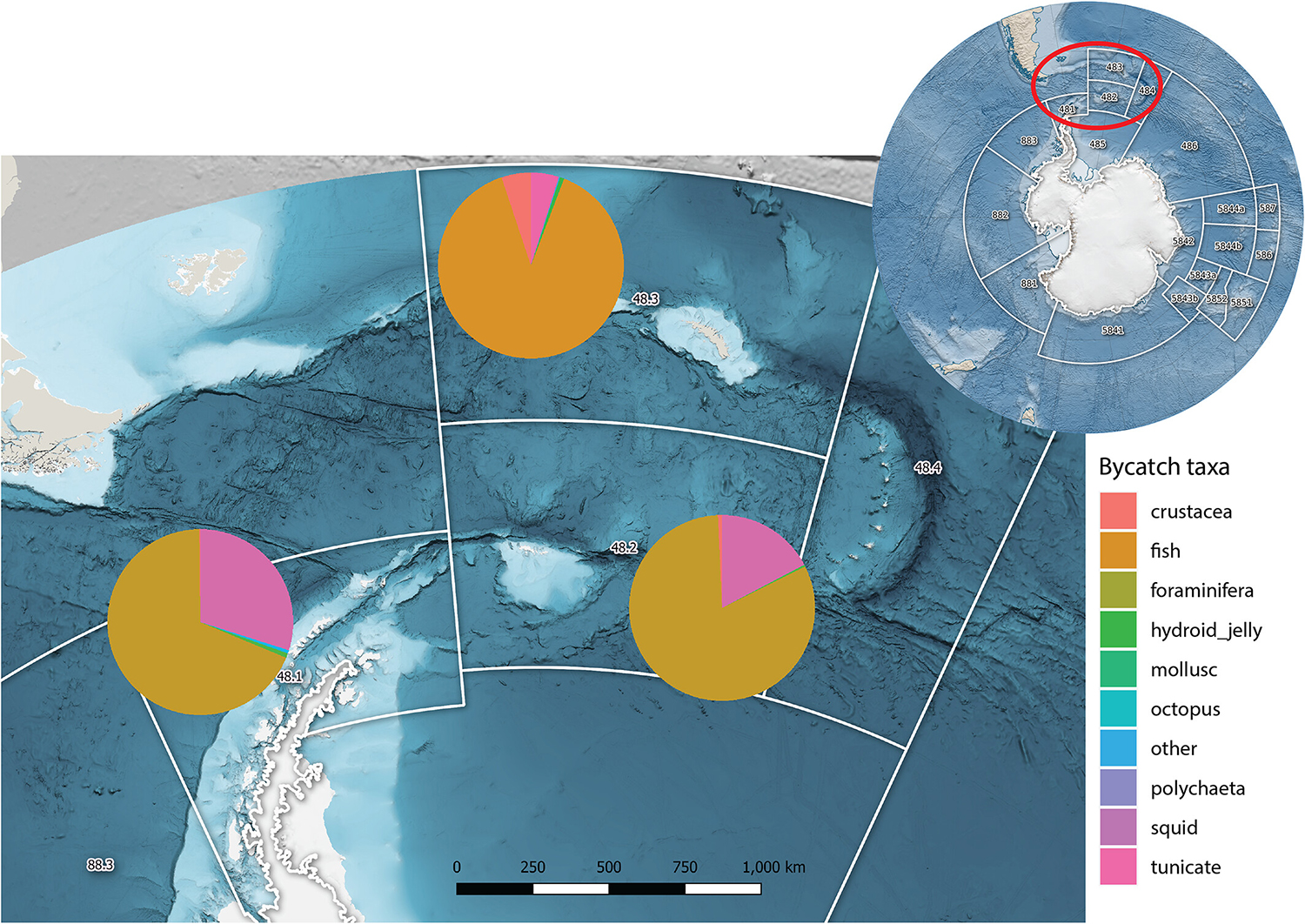
Bycatch in the Antarctic krill fishery (range = 0.1–2.2 percent) was lower than for other trawl fisheries globally (range = 10–55 percent), of which pelagic otter trawl fisheries are the lowest (10 percent). Bycatch sampling of fishing activity (observer coverage) in the Antarctic krill fishery was also high with a 20 percent coverage. If the observer samples are an unbiased sample of the fishery, literature review and simulation studies suggest that coverage levels of at least 20 percent for common species, and 50 percent for rare species, would give reasonably good estimates of total bycatch.
The highest weight of bycatch was during March–April in Subarea 48.1, February–March in Subarea 48.2, and June–August in Subarea 48.3 (Figure 2). Total bycatch was 25.1 (SD = 41.9) ton in Subarea 48.1, 14.9 (SD = 25.6) ton in Subarea 48.2 and 40.2 (SD = 54.8) ton in Subarea 48.3 (Fig. 2).
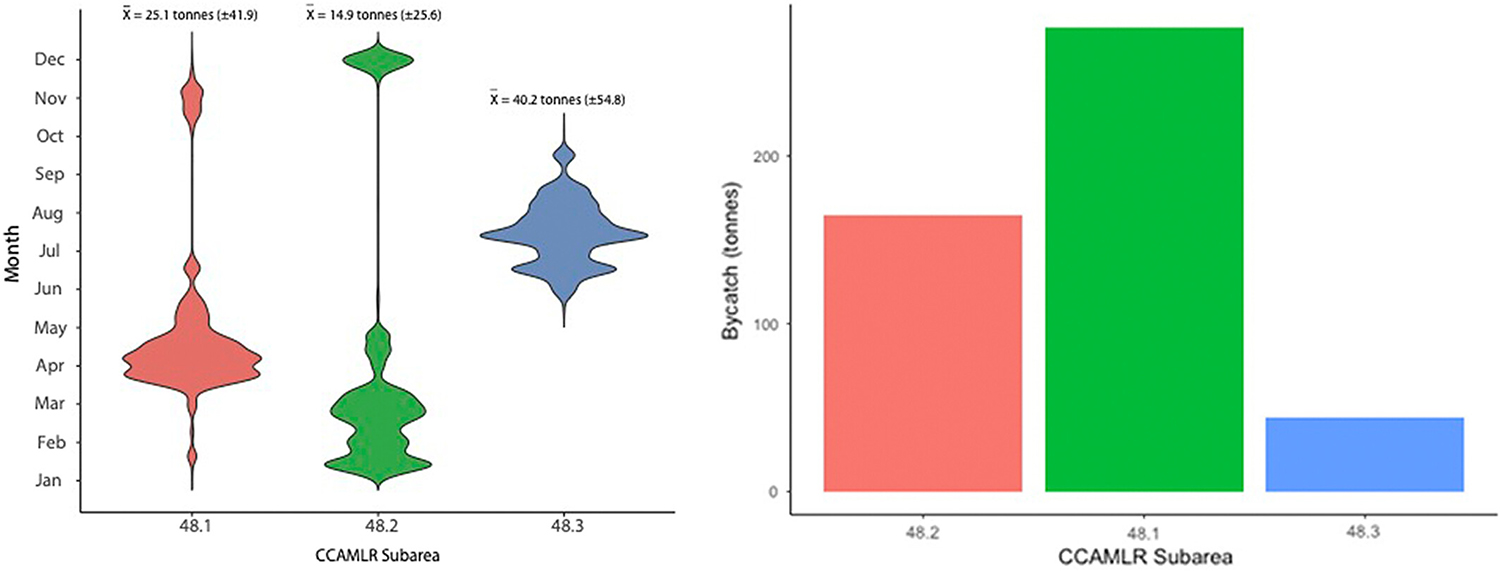
Total catch of Antarctic krill more than doubled, from 200,000 tons to over 450,000 tons, during 2010–2020 (Fig. 3). Catch increased during the preceding decade but increased the most during the last 3 years. Except in 2010 (2.2 percent), the bycatch ratio from SISO Observer logbook data ranged 0.1–0.3 percent. Total annual observed bycatch averaged 6.3 tons (±6.2 tons, range = 0.1–19.5 tons) by continuous pumping trawlers and 19.2 tons (±20.5 tons, range = 0.9–51.3 tons) by conventional trawlers during 2010–2020.
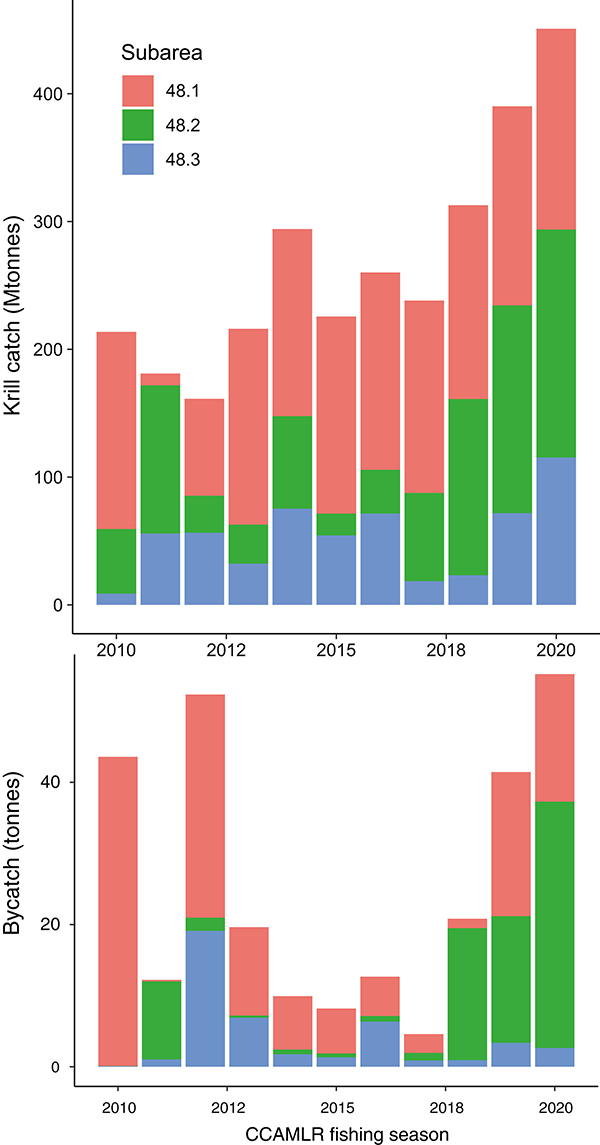
The Southern Ocean has a short-chained food web with many species, but only a few dominate its biomass. Antarctic krill are targeted by trawlers when aggregated in swarms large enough to maintain optimal factory productivity that seemingly contains few other species (this study), which likely explains the low bycatch in the Antarctic krill fishery compared to trawl fisheries in other ecosystems, particularly the large difference between our study and estimated discard for other crustacean trawl fisheries.
In the context of providing management relevant information concerning the potential ecosystem impact of bycatch, a higher degree of taxonomic information may be important. Reporting bycatch to the species level may enable more precise spatiotemporal monitoring, particularly for rare or ecologically important species. However, increasing resolution in the description of bycatch would likely require more taxonomic training of observers doing onboard monitoring, with a commensurate increase in workload. In the management of some other trawl fisheries, large efforts are devoted to streamline and reduce manual bycatch monitoring methods by employing new technologies like continuous camera monitoring and near-real-time bycatch description using machine and deep learning computational approaches, which likely will be the future solution also in the Antarctic krill fishery.
Reported discards from the Antarctic krill fishery decreased from almost 2000 tons in 2010 to nearly zero from 2018 onwards. These earlier, relatively high, levels of discards were presumably damaged or imperfect and therefore unfit for production. Given that the Conservation Measure CCAMLR put in place limited the discarding of catch to north of 60 degrees South, the trend of decreasing discards to zero presumably reflects the refinement and development of fishing technology over time culminating in the incorporation of all discards into the meal production process in recent years.
Similarly, since 2018 once bycatch is recorded to determine ecosystem impacts, it has then been used to manufacture meals. Consequently, bycatch in the Antarctic krill fishery is not a discarded waste product of marine resources as in other fisheries but a utilized aspect of the catch. The krill fishery is expanding, with two different fishing techniques both of which fluctuate greatly in rates of discard but with no clear difference between them. Future studies should assess whether one method consistently has a lower bycatch than the other method.
Total catch of Antarctic krill increased during 2010–2020 and is expected to continue to increase in the future due to increased market demand by the fish-farm feed industry and omega-3 nutraceuticals for human consumption, which constitute major products for krill. The fishery is also expected to expand beyond its current geographical extent into historical fishing grounds used in the 1970s and 1980s. Newer fishing vessels have a longer range and more storage capacity and extended use of supply vessels facilitates logistical challenges that can make fishing in these areas profitable. Quotas are already set and available in the South-West Indian sector of the Southern Ocean, but the potential diversity and distribution of bycatch species is also likely to differ.
Perspectives
The fishery today is well monitored through high observer coverage, which makes the approach robust in detecting any rapid changes in bycatch levels or composition in existing as well as in new fisheries. Maintaining a high observer coverage of fisheries bycatch is important as the temporal stability in bycatch patterns also will be impacted by a warmer climate.
Accurate data is essential to understand whether management strategies and implementing fishing method modifications are effective at mitigating impact. The review of the bycatch species we present here included groupings on a high taxonomical level, but observer data are available at a finer taxonomic resolution. For some species or groups, their representativeness to describe impacts from changes in the physical and biological environment can also be studied.
Now that you've reached the end of the article ...
… please consider supporting GSA’s mission to advance responsible seafood practices through education, advocacy and third-party assurances. The Advocate aims to document the evolution of responsible seafood practices and share the expansive knowledge of our vast network of contributors.
By becoming a Global Seafood Alliance member, you’re ensuring that all of the pre-competitive work we do through member benefits, resources and events can continue. Individual membership costs just $50 a year.
Not a GSA member? Join us.
Author
-
Bjørn A. Krafft, Ph.D.
Corresponding author and senior scientist
Institute of Marine Research, Bergen, Norway[111,110,46,105,104,64,116,102,102,97,114,107,46,110,114,111,106,98]
Tagged With
Related Posts
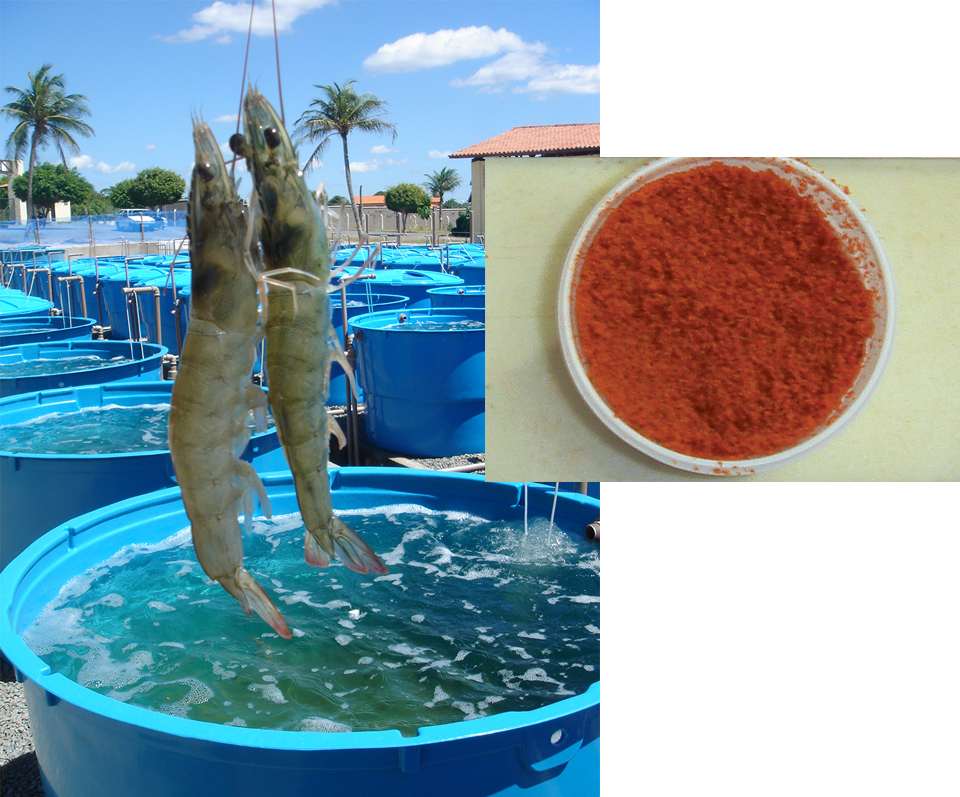
Health & Welfare
Krill meal use reduces other costly ingredients in shrimp study diets
Due to its high protein and highly unsaturated fatty acids content, krill meal can be an effective ingredient in aquafeed.
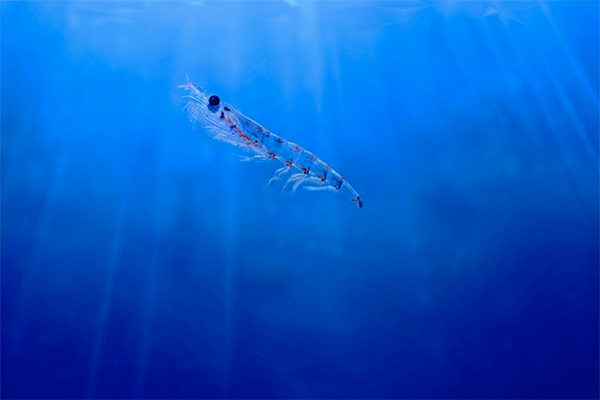
Responsibility
New evidence suggests Antarctic krill meal is a promising and responsibly harvested aquafeed alternative
New evidence indicates that Antarctic krill meal is beneficial in salmonid diets, and under certain conditions, can be sustainably harvested.

Aquafeeds
FDA approves krill products for farmed salmon feeds
Aker BioMarine announced that the U.S. Food and Drug Administration has approved its krill-based protein meal products for use in salmonid feeds.
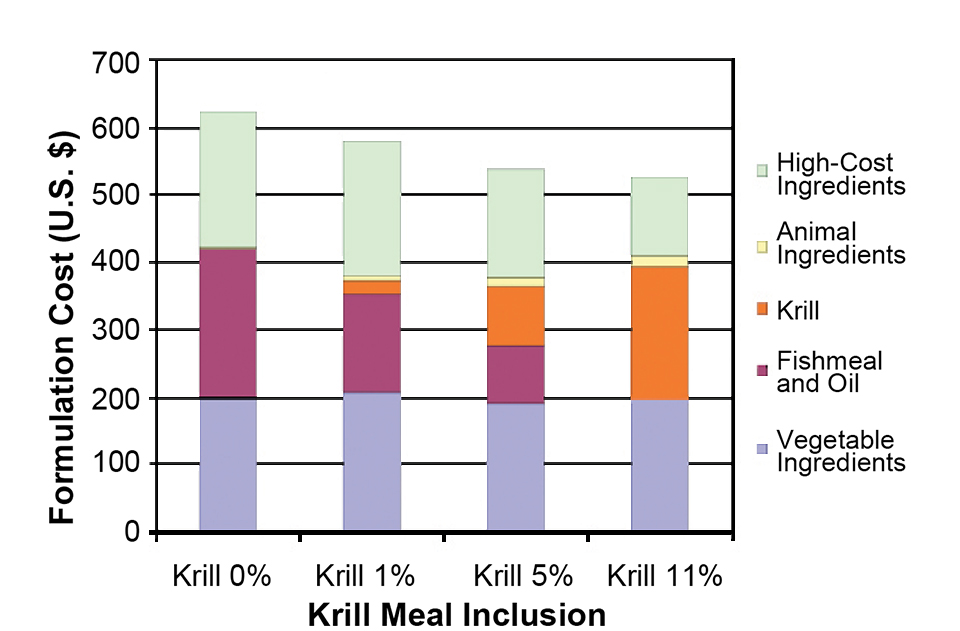
Aquafeeds
Study finds krill meal cost-effective ingredient in shrimp feed
In a study, krill meal incorporated into shrimp diets replaced fishmeal and soy lecithin with no significant effect on shrimp performance.



